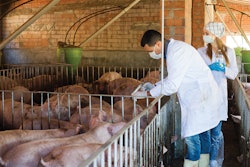
Copper can act as a substitute for antibiotics in poultry diets, but high levels can cause side effects
Copper, long used as an antimicrobial in hospitals and other applications, may prove a useful stand-in for antibiotics in poultry diets. But to achieve the desired antimicrobial effect requires high levels of copper which, if not fed carefully, can degrade performance, according to research by Trouw Nutrition.
Copper is a trace mineral and important nutrient in poultry diets. But to achieve an antimicrobial effect using copper requires 10-12 times more copper than would be included in poultry diets for nutritional purposes, according to Narendra Venkatareddy, global product manager of trace minerals for Trouw Nutrition. Venkatareddy presented several studies of various dosages and forms of copper supplementation during a webinar held November 5.
Fed at lower levels, Venkatareddy said, copper acts as an antioxidant, boosts the immune system, and contributes to the maintenance of skin and the nervous system. But to achieve a true antimicrobial effect, Venkatareddy said, requires copper concentrations that exceed 200 parts per million.
“It is not until 200 parts per million that you get a reduction in different species of bacteria,” he said, with even greater impact observed at 400-600 parts per million.
Fewer pathogenic bacteria in the gut would mean fewer harmful microbes to siphon off nutrients, which in turn promotes better growth performance, Venkatareddy said. But feeding extremely high levels of copper can also reduce feed intake, resulting in decreased growth performance that can begin at levels as low as 100 parts per million, depending on the reactivity of the form of copper included in the diet. Producers, he said, should not include 400-600 parts per million of copper in poultry diets, despite the potential antimicrobial effect.
Highly reactive forms of copper, such as copper sulfate, can also react with other ingredients in the feed, reducing the shelf life of key vitamins, Venkatareddy said. Using a less reactive form of copper, such as chelated copper, copper oxides or Trouw’s IntelliBond C, a copper chloride product, may cost more but will help to mitigate the risks associated with including high levels of copper in poultry diets, he said.
These less reactive forms of copper come with an added benefit, Venkatareddy said. As the starches and proteins included in the diet are digested, the copper remains, becoming more concentrated as it moves through the intestinal tract. This makes it possible to achieve sufficient concentrations to kill bacteria in the lower gut, without exceeding safe levels in the diet. A diet containing just 150 parts per million of low-reactivity copper will result in concentrations of 375 parts per million in the gut, Venkatareddy said.













